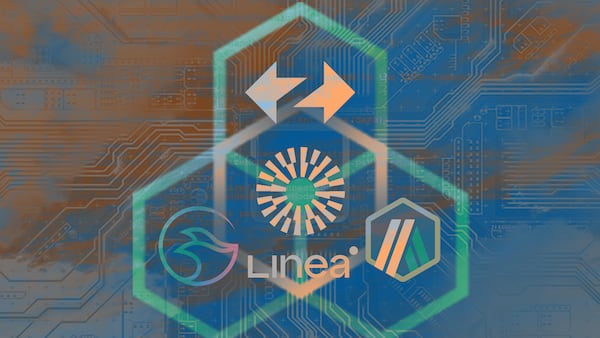- An upgrade called Stylus would let developers write smart contracts in Rust and other popular programming languages.
- It follows Ethereum's Dencun upgrade which brought sub-cent transactions to layer 2 blockchains.
- Arbitrum DAO is expected to approve the upgrade.
A month after a major upgrade slashed fees on the layer 2 blockchains that process most of Ethereum’s transactions, one is poised to become even cheaper.
The digital cooperative that governs Arbitrum is expected to approve an upgrade dubbed “Stylus” this spring. The upgrade will let developers build applications for Arbitrum using popular programming languages Rust, C, and C++.
This could enable applications that are currently impractical on Ethereum and the blockchains built atop it, such as advanced cryptography and on-chain machine learning, according to Steven Goldfeder, CEO of Offchain Labs, the company that built Arbitrum.
“I think we’ll see brand new applications opened up that simply weren’t possible before,” Goldfeder told DL News in an interview earlier this month.
Friendly development
It could also make crypto development more friendly for software developers who have been turned off by Solidity, a relatively obscure programming language exclusive to Ethereum.
It’s the latest salvo in the increasingly competitive market for layer 2 blockchains, which are central to Ethereum’s ambition to become a mass-market, all-purpose digital platform.
Ethereum is prone to congestion and variable transaction fees that occasionally reach hundreds of dollars.
So-called layer 2 blockchains that funnel into Ethereum are faster, far cheaper, and, their developers hope, the most pragmatic way to make Ethereum applications cost-competitive with the existing giants of finance and social media.
Arbitrum has long led the layer 2 race.
As of Wednesday, Arbitrum accounted for 44% of all crypto deposited on Ethereum’s four dozen layer 2 blockchains, according to L2BEAT.
But it has steadily lost market share over the past year as the number of competitors ballooned.
In March, a long-awaited Ethereum upgrade code-named “Dencun” slashed layer 2 transaction fees by as much as 98%.
On Thursday, the cost to send Ether on Arbitrum and Optimism, another L2, was less than a penny, according to l2fees.info. But certain applications are still cost-prohibitive.
Computation costs
Stylus’ expected benefits will come primarily from saving on smart contracts’ computation costs, according to Rachel Bousfield, the Offchain Labs engineer that led development of the upgrade.
“Computation is now 10 to 100 times cheaper depending on what exactly you’re doing,” she told DL News in an interview right after Stylus’ launch on a test network last year. “It just makes possible all sorts of really powerful financial primitives.”
Saving on computation costs has become even more important in the wake of Dencun.
Although Dencun reduced the cost of posting layer 2 data to Ethereum — and, in turn, making transactions far cheaper — it didn’t increase the number of transactions layer 2 blockchains could process.
Shortly after Dencun, a tsunami of transactions on Base, an Arbitrum competitor, led to network congestion, causing transaction fees there to briefly spike above pre-Dencun levels.
Saving on computation, on the other hand, means the chain can handle more transactions.
“By cutting compute 10x, we increase capacity 10x,” Bousfield said Wednesday. “Given the spectre of congestion for L2s in the [post-Dencun] world, it’s more important now than ever to cut compute costs.”
Talent influx?
Rust, C, and C++ are more efficient than Solidity, the programming language used by the vast majority of developers building applications for Ethereum and its dozens of layer 2 blockchains.
Letting developers write smart contracts in those languages could increase the pool of talented developers willing to work in crypto.
According to an Arbitrum estimate, some 20,000 developers write code in Solidity. More than 3 million use Rust, and more than 10 million use C and C++.
“Right now, if [companies] want to get into DeFi, they have to ... retrain their engineers so that they can learn these new tools and all of this complicated stuff in Solidity,” Bousfield said.
The future of smart contracts
Stylus takes smart contracts written in Rust, C, and C++, and converts them to WebAssembly, a format popular in web browsers like Google’s Chrome or Mozilla’s Firefox.
“It has a few qualities that make it great for blockchain,” Bousfield said of WebAssembly. Like browsers, blockchains are resource-constrained. They’re also a target for hackers.
“A web browser is a very untrusted, very dangerous environment, right? You’re loading code from a website that could potentially try to do all sorts of malicious things.”
Harry Kalodner, Offchain Labs’ chief technology officer, said the company was making a bet on WebAssembly with Stylus.
“The world decided quite a while ago that WebAssembly is the future of the web,” he told DL News in an interview last year. “And basically, we think that WebAssembly is also the future of smart contracts.”
The Arbitrum DAO, the digital cooperative that has run the blockchain since March 2023, is expected to approve the Stylus upgrade, though deliberation, voting, and execution might not conclude until June, Bousfield said.
Should Stylus pass, any benefits will be realised as Arbitrum-based protocols roll out smart contracts written using Stylus.
Aleks Gilbert is DL News’ New York-based DeFi correspondent. You can reach him at aleks@dlnews.com.







